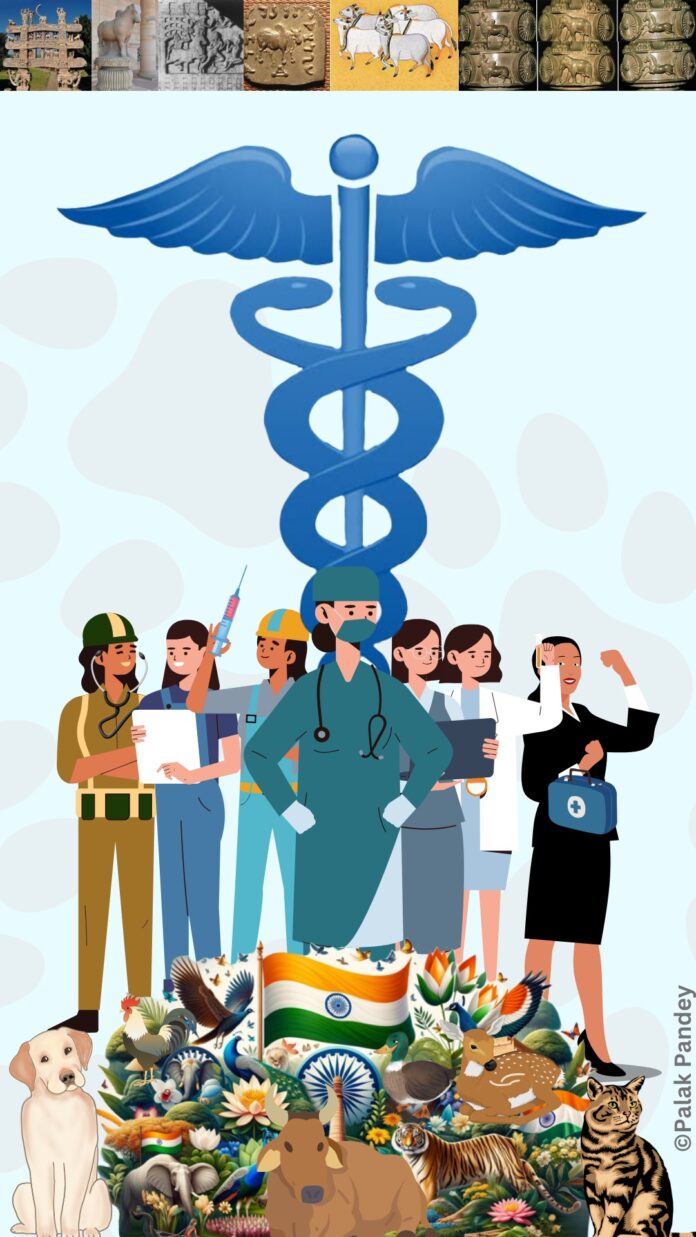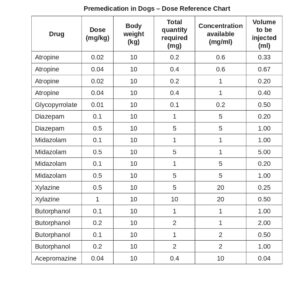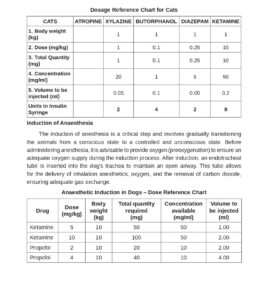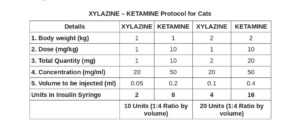ANAESTHETIC PROTOCOLS OR TECHNIQUES IN DOGS AND CATS
Dr. S. Senthil Kumar, M.V.Sc., Ph.D., FISVS,
Professor and Head
Department of Veterinary Surgery and Radiology
Veterinary College and Research Institute
Tamil Nadu Veterinary and Animal Sciences University, Salem – 636 112
Introduction
Anesthesia plays a crucial role in ensuring the well-being and success of surgical
interventions in dogs and cats. The administration of anesthesia in veterinary medicine
allows for safe and efficient surgeries while minimizing pain and discomfort for the
animals. The use of anesthetics is essential in ensuring the success of various surgical
procedures, from routine spaying and neutering to complex surgeries. Anesthetics
are the cornerstone of modern veterinary surgery, as they induce a reversible state of
unconsciousness and insensitivity to pain, enabling veterinarians to perform procedures
with precision and minimal distress to the animal. Anesthetics ensure that the animal is
completely unaware and unresponsive during the surgery, preventing stress, anxiety, and
pain. Anesthetics help maintain stable vital signs such as heart rate, blood pressure, and
respiration throughout the procedure, reducing the risk of complications. Anesthesia is
an indispensable tool in veterinary medicine, ensuring that surgical interventions in dogs
and cats are carried out safely, with precision, and in a humane manner. Anesthetics not
only alleviate pain and discomfort but also contribute to a more efficient and successful
surgical outcome, benefiting the overall well-being of companion animals.
Preanaesthetic Preparation And Assessment
The preparation of dogs and cats and preoperative assessment for anesthesia is
a critical and meticulous process that ensures the safety, well-being, and successful
outcome of surgical or medical procedures.
Body Weight Measurement
Determining the accurate body weight of the animal is crucial for calculating the
correct dosage of anesthetic drugs. Underestimating or overestimating the body weight
can lead to inadequate or excessive anesthesia, which can result in complications or an
incomplete procedure.
Dose Calculation
Accurate dose calculations ensure that the animal receives the appropriate amount
of anesthetic agents, analgesics, and other medications. This precision minimizes the 4
risk of overdose or underdose, promoting the animal’s safety and comfort during the
procedure.
Rule of 5
- Estimate the Body weight (kg)
- Dose of the drug to be administered (mg/kg)
- Total quantity of drug required (mg) = Body weight x Dose
- Concentration of the drug in the formulation (mg/ml)
- Volume to be administered (ml) = Total quantity required (mg) / Concentration
(mg/ml)
Physical Examination
A thorough preanaesthetic physical examination is a mandate to identify any
underlying medical conditions or concerns that might affect the anesthetic protocol.
Evaluating heart and lung function and identifying signs of infection should be done and
addressed before anesthesia to prevent complications.
Hematology and Biochemistry Studies
Hematology and biochemistry studies involve blood tests that provide valuable
information about the animal’s overall health. These tests can reveal anemia, infection,
organ dysfunction, or other underlying conditions that might contraindicate anesthesia
or require special precautions.
Preoperative assessment is a fundamental aspect of preparing dogs and cats for
anesthesia. Accurate body weight measurement, dose calculation, physical examination
and hematological and biochemical study are essential for identifying and addressing
potential risks and optimizing the anesthesia protocol. This comprehensive approach
ensures the safety and well-being of the animal and contributes to the success of
anaesthetic and surgical procedures.
Intravenous (IV) access
Intravenous (IV) access is of significant importance during anesthesia in dogs and
cats for several reasons, as it plays a critical role in ensuring the safety and effectiveness
of the anesthesia and surgical procedures. Anesthesia involves the administration of
various medications, including induction agents, analgesics, muscle relaxants, and
maintenance anesthetics. IV access allows for the precise and controlled delivery of
these drugs, ensuring that the animal is adequately anesthetized and that the level
of anesthesia can be adjusted as needed. In the event of an emergency, such as cardiovascular instability or an adverse reaction to anesthesia, IV access is vital for the
rapid administration of life-saving medications. During anesthesia, maintaining proper
fluid balance is critical to prevent dehydration, hypotension, and electrolyte imbalances.
IV access allows for the administration of intravenous fluids to support blood pressure
and maintain hydration. Intramuscular injections or other routes may cause discomfort
and stress in the animal. IV access is a less painful and less stressful option for
administering drugs and fluids.
Premedication
Premedication in the context of anesthesia refers to the administration of drugs or
medications before the induction of general anesthesia. Premedication contribute to the
overall safety and success of surgical and medical procedures in veterinary practice.
Indications for premedication
One of the primary reasons for premedication is to reduce anxiety and stress in
dogs and cats before surgery. Premedication often includes sedatives, which help calm
and relax the animal. Premedication may include analgesics. This helps to preemptively
alleviate pain and discomfort, making the transition to general anesthesia smoother and
reducing the amount of anesthetic required.
Commonly used Premedicants in Veterinary Practice
*. Atropine and Glycopyrrolate: Used to counteract excessive salivation and
bradycardia.
* Diazepam and Midazolam: Induce sedation, muscle relaxation, and reduce
anxiety.
*Alpha-2 Agonists – Xylazine and Dexmedetomidine: Provide sedation and
analgesia.
* Opioids: Butorphanol, Buprenorphine and Pentazocine for analgesia
* Tranquilizers – Acepromazine: A phenothiazine tranquilizer that induces
sedation and reduces anxiety.
*Non-Steroidal Anti-Inflammatory Drugs (NSAIDs): Meloxicam and Carprofen
can provide pain relief and anti-inflammatory effects in the preoperative period.
*Local Anesthetics – Lidocaine and Bupivacaine: Local anesthetics can
be administered regionally to block pain at the surgical site, reducing the
anesthetics / analgesics administered.
*. Dexamethasone: Sometimes used to reduce inflammation and allergic reactions, though its use as a premedicant is relatively uncommon.
It’s important to note that the choice of premedicant drugs and their combinations
depends on various factors, including the specific procedure, the patient’s health status,
and the desired level of sedation, analgesia, and muscle relaxation
Induction of Anaesthesia
The induction of anesthesia is a critical step and involves gradually transitioning
the animals from a conscious state to a controlled and unconscious state. Before
administering anesthesia, it is advisable to provide oxygen (preoxygenation) to ensure an
adequate oxygen supply during the induction process. After induction, an endotracheal
tube is inserted into the dog’s trachea to maintain an open airway. This tube allows
for the delivery of inhalation anesthetics, oxygen, and the removal of carbon dioxide,
ensuring adequate gas exchange.
Use of Local Anaesthetics
A simple application of local anesthesia in a testicular block involves injecting a
drug directly into the testicle, allowing it to travel to the spermatic cord. This helps reduce
pain during the procedure and afterward when the cord and associated blood vessels
are surgically manipulated. The amount of anesthesia used can vary, with typically 0.2
to 2.0 ml of 2% lignocaine administered per testicle, adjusting the dosage based on the
size of the dog or cat.
Intraperitoneal lavage with lignocaine is a technique used during ovariohysterectomy
(spaying) in female dogs to desensitize the serosal surfaces within the abdominal cavity,
including the ovarian and uterine tissues.
Lignocaine Dosage: Dogs: 4-6 mg/kg; Cats: 2-4 mg/kg
Dilution: Mix lignocaine with an equal volume of sterile saline.
(Prepare a solution consisting of 2.5 ml of 2% lignocaine and 2.5 ml of saline per
10 kg of the animal’s body weight).
The lignocaine-saline mixture is instilled into the abdominal cavity either immediately
after the abdominal wall is incised or just before abdominal closure. This technique
helps reduce pain and discomfort during and after the surgical procedure, making it
more comfortable for the animal.
Anaesthetic Maintenance
Maintenance of anaesthesia is carried out preferably with inhalation anesthetics
(e.g., isoflurane or sevoflurane) administered through the endotracheal tube.
Anaesthetic maintenance can also be carried out with total intravenous anaesthesia by
administering anaesthetic agents in combination with other adjuncts employing constant
rate infusion technique or repeated bolus technique to maintain adequate plane of
surgical anaesthesia.
TIVA PROTOCOL FOR DOGS
Simple CRI Anaesthetic Maintenance
Butorphanol + Lidocaine + Ketamine
Loading Dose
Loading Dose – Butorphanol 0.1 to 0.2 mg/kg; Lidocaine 1 to 2 mg/kg;
Ketamine 1 mg/kg
0.5 to 2 ml Butorphanol / 10 kg; 0.5 to 1 ml Lignocaine / 10 kg; 0.2 ml
Ketamine / 10 kg
Maintenance Dose
CRI – Butorphanol 0.1 to 0.2 mg/kg/h; Lidocaine 3 to 4 mg/kg/h;
Ketamine 5 to 10 mg/kg/h
(1 ml Butorphanol + 2 ml Lidocaine + 2 ml Ketamine is added to 100 ml NS and
administered i.v. for anaesthetic maintenance @ 32 Drops per minute to a Dog
weighing 10 kg)
FLOW RATE CAN BE ALTERED AS REQUIRED
IV set with IV tubing Drop factor of 20 Drops/ml will deliver 100 ml/h at a flow rate
of 33 Drops/minute
Anesthetic Monitoring
Monitoring anesthesia is of paramount importance to ensure the safety and well-being
of the animals undergoing surgical or medical procedures. Comprehensive monitoring
involves assessing various physiological parameters, including heart rate, cardiovascular
function, respiratory function, oxygenation, ventilation and ECG. Monitoring heart rate
provides insights into the cardiovascular status of the patient. Significant changes in heart
rate can signal potential issues such as arrhythmias, cardiac stress, or hypovolemia.
Sudden elevation in heart rate or respiratory rate may indicate inadequate analgesia during surgical intervention. Continuous monitoring of blood pressure is essential to
detect changes in perfusion, which can indicate inadequate oxygen and nutrient supply
to vital organs. Monitoring respiratory rate and quality helps ensure that the patient is
adequately ventilated. Oxygen saturation (SpO2) monitoring is crucial for assessing the
adequacy of oxygen in the blood. A sudden drop in oxygen saturation can be an early
warning sign of respiratory compromise. Capnography measures the carbon dioxide
concentration at the end of each exhalation. It provides information about the patient’s
ventilation and helps detect potential issues like airway obstructions or malpositioned
endotracheal tubes. Assess mucous membrane color, which should be pink and moist, to
gauge circulation and oxygenation. Breathing pattern and effort should be monitored to
ensure it is regular and unlabored. Rapid or shallow breathing could indicate respiratory
distress. Muscle relaxation should be assessed and it gives inference on the adequacy
of anaesthetic depth for the surgical intervention. Electrocardiography (ECG) allows
for continuous monitoring of the heart’s electrical activity. Detecting arrhythmias or
irregularities is critical to prevent complications. Monitoring helps anesthetists adjust
the depth of anesthesia as needed, avoiding overdosage or underdosage of anesthetic
agents. This ensures that the patient is neither too deeply anesthetized nor inadequately
sedated. Continuous monitoring allows for the early detection of any issues, enabling
prompt intervention. This is crucial in preventing anesthesia-related complications and
ensuring patient safety. Comprehensive monitoring during anaesthesia contributes to
safer and more successful surgical procedures, ultimately leading to better outcomes.
Anesthetic Recovery
The anesthetic recovery phase is a critical period that requires careful monitoring
and management to ensure the patient’s safety and well-being. Anesthetic recovery is
a vulnerable period where dogs /cats are regaining consciousness and control of their
bodily functions. Ensuring a smooth and uneventful recovery is essential for their safety.
Continuous monitoring during recovery allows for early detection of complications or
adverse events, enabling immediate intervention if necessary. Post-operative pain
management often begins during the recovery phase. Proper pain control enhances the
comfort and aids in a smoother transition from anesthesia. Continue to monitor heart
rate, respiratory rate, and oxygen saturation. These parameters provide insights into
the cardiovascular and respiratory function. Hypothermia is a common concern during
anesthetic recovery, and preventing it is crucial for the dog/cats’s comfort and recovery
process. Dogs are susceptible to hypothermia during recovery due to the effects of
anesthesia. Monitor their body temperature and take steps to maintain warmth. Ensure
that the recovery area is warm and draft-free. Use heating pads, warm blankets, or heated cages to maintain a comfortable ambient temperature. The administration
of warmed intravenous fluids helps in maintaining the dog’s core body temperature.
Covering the dog with snug, dry blankets or materials designed for insulation minimize
the heat loss. Particular focus should be placed on areas prone to losing heat, like the
extremities. Ensure the dog stays dry, as damp fur can greatly increase heat loss.
In conclusion, ensuring safe anesthetic outcomes in dogs and cats involves
careful attention to detail and a dedication to their well-being. Following pre-anesthetic
preparations, continuous monitoring, and creating a comfortable recovery environment
significantly enhances safety and success. The comprehensive approach demonstrates
a commitment to patient safety, reduces risks, and ensures the health and well-being of
our canine / feline companions during anesthesia.






